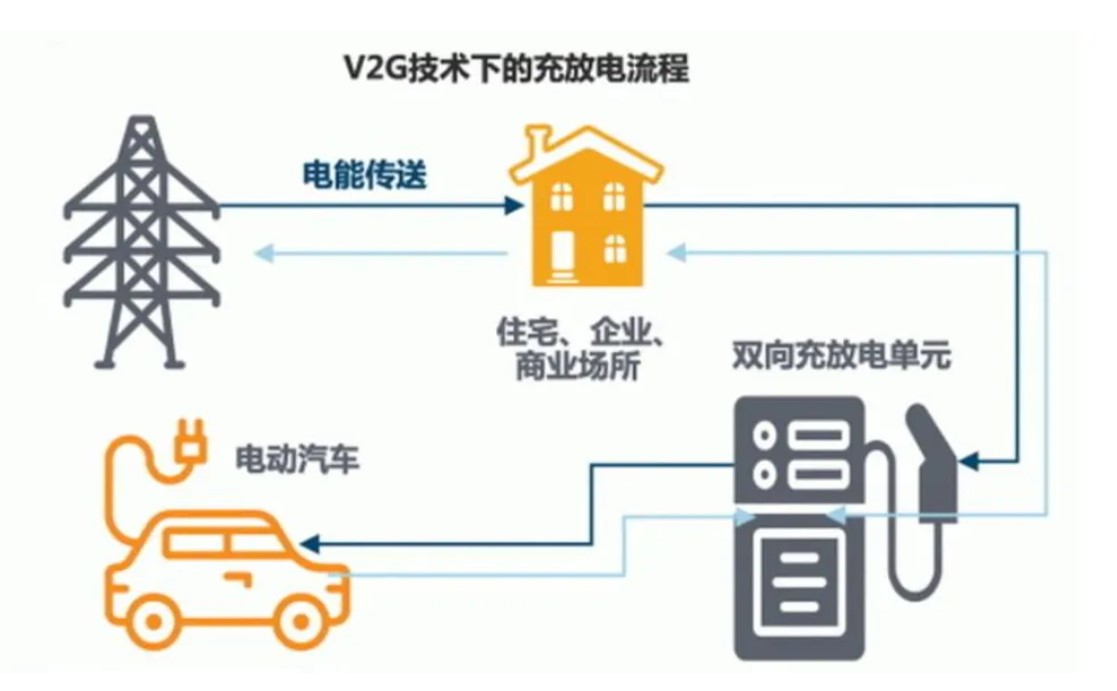Vehicle-to-grid (V2G) is a system that allows electric vehicles (EVs) to communicate with the public grid and even supply power to the grid to meet energy needs.
V2G for car owners
Electric cars spend most of their time charging at the owner's house or parking lot.
Today's electric cars are able to communicate with a charger, telling it how much the battery is currently charged and how fast the vehicle is receiving power. In the future, V2G could securely communicate payment information at public charging stations and unlock other features by establishing a cybersecurity gateway between the vehicle and the manufacturer. Aligning V2G hardware with the HomePlug standard speeds up data and improves security by enabling vehicles to connect to the Internet via the house's internal power cord.

V2G will also allow consumers to power their homes with an electric vehicle's battery during a power outage. Owners could even use their vehicles' considerable battery capacity to sell power back to the grid during peak load. Users can place a cap on the amount of power they can consume to prevent overuse of the battery, and they can further customize the Settings by choosing to buy back the power when it is cheaper and sell it back to the grid only at peak prices.
V2G for original equipment manufacturers
V2G technology facilitates faster, more secure communication paths between vehicles and manufacturers. Direct connectivity can provide consumers with access to third-party and OEM-branded app ecosystems, thus opening the door to additional features and future revenue opportunities. In addition, giving Oems better control over the charging process will help them optimize the charging cycle based on the specific battery chemistry of the EV, thus extending the overall battery life and increasing consumer appeal. Currently, the "brain" of the charging process resides in the charger itself; As Oems develop V2G, the processing power will go into the car.
V2G for utility providers
While electric vehicles have great potential to reduce CO 2 emissions, they are only as clean as the electricity they use. To achieve a fully green economy, it is essential to decarbonize electricity production at source. But replacing fossil fuels with renewable alternatives poses unique challenges.
The grid must maintain a balance between generation and consumer demand. Fossil fuels can generate electricity when needed, but solar and wind are affected by environmental factors that make them more volatile - that is, solar panels produce more energy during periods of direct sunlight, and wind turbines produce more energy during high winds.
As the energy industry adopts more of these alternatives, grid-scale power storage becomes critical for storing electricity as it is generated so that it can be consumed later. V2G technology offers a solution that brings benefits to car owners, utilities, and Oems.
Most EV batteries have the capacity to power a typical American home for several days. As more consumers use electricity, utility providers can forego the manufacturing costs associated with high-capacity batteries and instead utilize plug-in EVs for power storage as they convert most of their electricity production to renewable energy. Such an approach would save utilities costs and shorten the path to a carbon-neutral world.
One of the biggest challenges in implementing V2G is getting utilities and vehicle Oems on the same page. The ISO 15118 V2G protocol addresses this issue by providing common standards for engineers in both industries.
APTIV has developed a V2G gateway for the masses, called Smart Architecture Charging Interface Device (SACID), which is V2G compliant and uses transport layer security to ensure that network security connections are the same as protocols that support HTTPS Web traffic encryption and authentication. SACID is compatible with all zone charging standards and improves functional security by locking the connection between the plug and the entry and using three temperature sensors to automatically stop charging when the temperature exceeds a safe limit. SACID contracts have since been awarded by other Oems.

APTIV's portfolio of software and hardware products is well-equipped to address all aspects of the charging process, from modular inlets with active cooling capabilities to buses that enable high-voltage connections within the battery pack. Our extensive experience with the vehicle's brain and nervous system allows us to ensure that SACID is compatible with next-generation high-voltage charging solutions.

